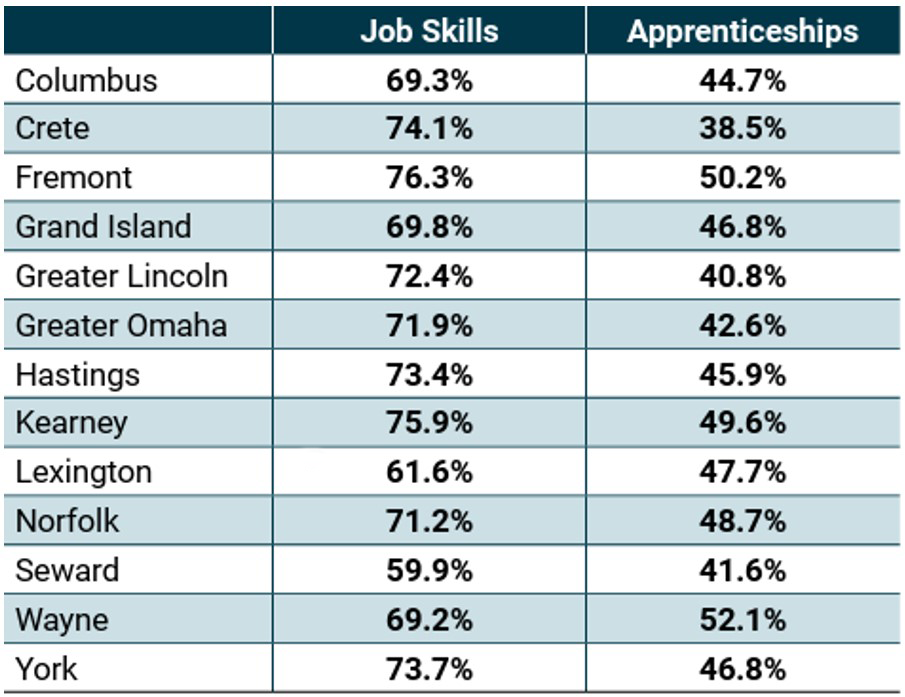Cornhusker Economics Feb 14, 2024
Increasing Workforce Skills: The Possible Disconnect between Employers and Potential Job Seekers
Here is the situation: You own a small manufacturing business in Nebraska. You would like to grow your business, but you are having a tough time hiring people with the right skills. So, you think that offering training to potential job seekers could be the answer. Well, maybe it is and maybe it is not, according to the recent issue of the Nebraska Workforce Trends online magazine. (https://dol.nebraska.gov/trends).
In a multi-year survey of potential job seekers, those who are likely to change jobs in the next year or who are likely to reenter the workforce in the next year, several key training obstacles for improving their employment situation were identified. There seemed to be only slight differences in how they viewed these challenges, regardless of whether they saw their potential job as a career, a steppingstone to a career, or just a job to get by. The cost of training, the lack of available training, the distance or transportation to the training, lack of time, and the knowledge of what is available were all substantial barriers to training (see Table 1.).
Table 1.

Nebraska Workforce Trends 2024, Jan-Feb, pg. 7
https://dol.nebraska.gov/trends
When you look at this list it appears these obstacles could be easily overcome. The cost can be reduced in a variety of ways by working in partnership with educational institutions or businesses with similar needs. The distance to the training or the availability of training can be addressed with potential in-house or regional instructors. State grants through the Department of Labor Worker Training Program are also available to help with both availability and cost. The most puzzling obstacle could be the lack of communication on what training is available and allocating the time to attend the sessions. If job seekers do not know what is available, it becomes impossible for them to participate, even if they know they should participate. Almost a third of the potential job seekers (31%) shared that the lack of training was getting in the way of improving their employment situation.
Now let us look at this situation through the eyes of employers. In this same multi-year survey conducted by the Department of Labor, they asked employers what training they offer for their difficult to hire occupations. Job skills were defined as an “upgrade or extend employee skills or qualify workers for a job” and apprenticeships are identified as “classroom or on-the-job training to become a skilled worker.” The table shows the percentage of employers in each geographic area that offer job skills training or apprenticeships (Table 2).
Table 2.

Nebraska Workforce Trends 2024, Jan-Feb, pg. 8
https://dol.nebraska.gov/trends
For job skills training, participation ranges from 59.9 % in Seward to 76.3 % in Fremont. And for apprenticeships, the range of employer involvement starts at 38.5% in Crete and goes to 52.1 % in Wayne. What this tells us is that there is a substantial amount and variation of training opportunities available.
So where is the disconnect between potential job seekers and employers? Perhaps the “devil is in the details”? From the potential job seeker's viewpoint, is it hard for them to find information on the training? Are the trainings offered to just current employees and not potential new employees? Are they offered at times and places where they can easily attend? Are these trainings focused on mid-level skills or are they available to entry-level potential job seekers? Do training times conflict with current job schedules, making it difficult to attend? For the employer, what strategies do they use to reach potential job seekers with an interest in employment? Are there ways to pool training on a regional basis to make it more affordable for employers to subsidize? Are there new opportunities to look at mid-level career skills through the lens of experience and testing to speed up the training process?
It is easy to generalize, but in reality, each business situation has unique needs, challenges, and opportunities. But asking tough questions, even those that get into specifics, may be the only way to make training accessible and available to those that want and need it. When this becomes a reality, both job seekers and employers benefit.
Reference:
Nebraska Workforce Trends (2024). January/February. Nebraska Department of Labor. Available at: https://dol.nebraska.gov/trends